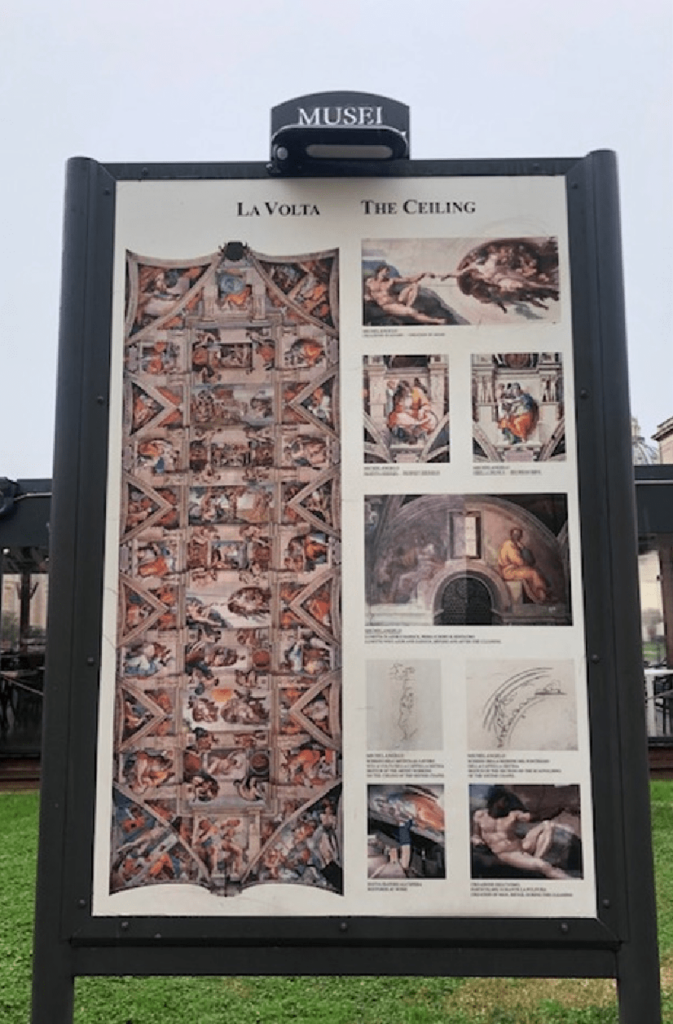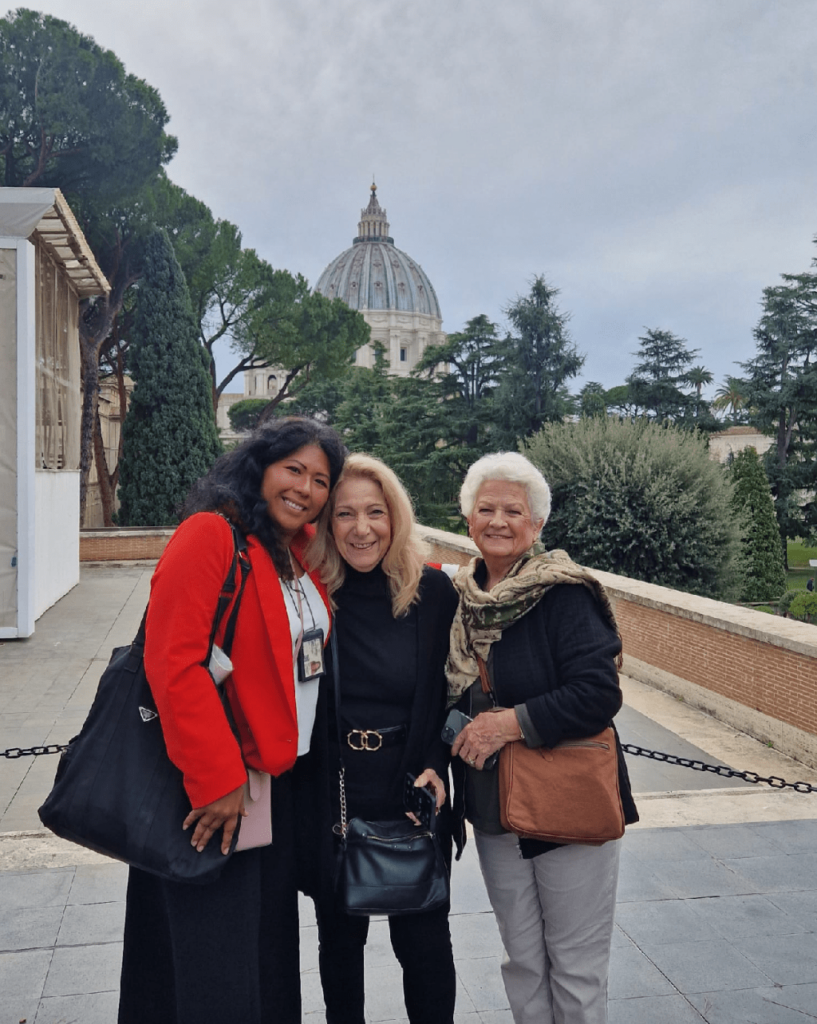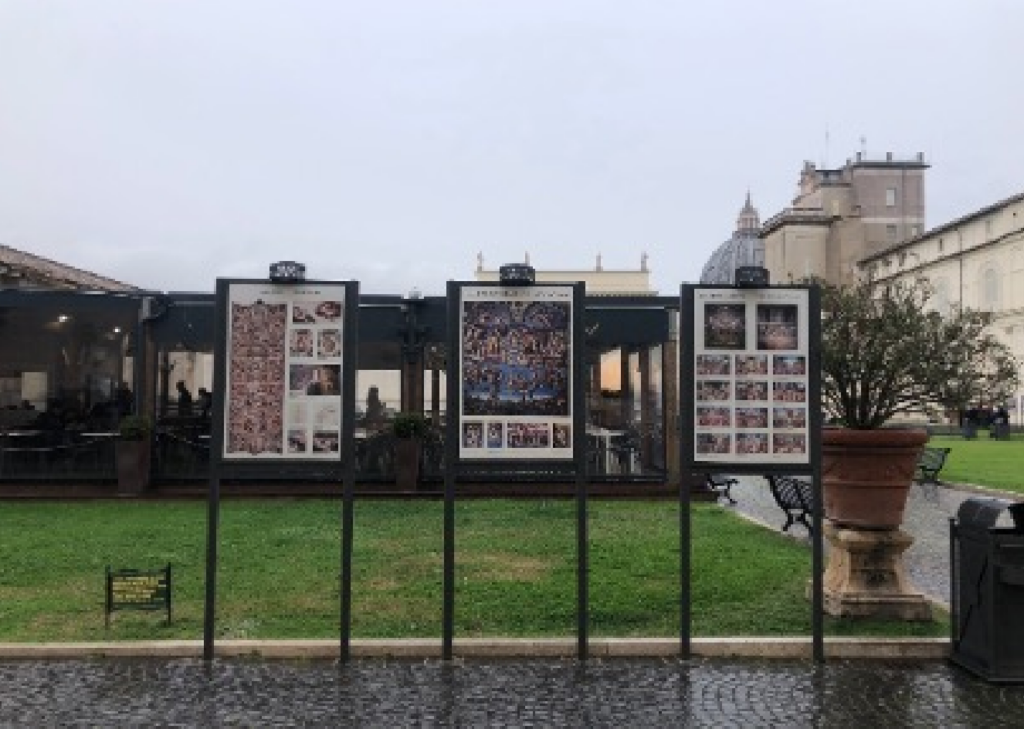A TORAH TOUR OF THE SISTINE CHAPEL WITH SARA TERRACINA
Millions of tourists have entered the Sistine Chapel for more than five hundred years. Tour guides usher their massive size tour groups, while other guides try to squeeze in their private clients through in ten to twenty minutes leaving them to gaze in awe by the powerful story of the Torah.
According to Jewish tradition, Jews have called the writings of the Hebrew Bible the Tanakh. It is an abbreviation of the words Torah (the five books of Moses; Genesis, Exodus, Leviticus, Numbers, Deuteronomy, also called Pentateuch, Nevi’im (the historical prophetic books), and Ketuvim (the remainder of the inspired writings or wisdom literature of the Hebrew Bible). The Torah derives from the homonymic Hebrew root “y-r-h”. This root meant “to teach”. The term Old Testament is the Christian name for the Hebrew Bible.
A Torah Tour of the Sistine Chapel is specifically curated for Jewish visitors who want to visit the Vatican Museums and the Sistine Chapel with a Jewish tour guide. During this tour, participants will see the highlights of the Vatican Museum, ancient artefacts, the art masterpieces with links to the Jewish history of Rome.

Your guide is Sara Terracina, a member from of the Jewish community of Rome. She provides specialized tours for tourists visiting Rome and Italy who are interested in Jewish history and culture. Her mission is to show visitors how the eternal city is an amazing place where ancient Romans, the Popes and the Jewish community struggled, but succeeded to coexist over the centuries.
The Torah Tour of the Sistine Chapel is a three-hour walking tour inside the vast complex of the Vatican Museums. The Sistine Chapel plays an important role in the Roman Catholic Church. It is the place where the Sacred College of Cardinals, gather to elect popes. The Sistine Chapel did not start during the Renaissance, it was originally built during the Middle Ages. The first written documentation relating to its existence dates to 1368. It was called the capella papalis, or Papal Chapel. Pope Sixtus IV (Francesco della Rovere 1471-1484) decided to rebuild the chapel as part of his preservation plan to beautify Rome and of course, immortalize his papacy. The chapel was named the Sistine Chapel in his honor. Construction on the chapel began in 1477 by a the Florentine architect Baccio Pontelli.
Pontelli was a military architect and was commissioned to build a chapel with both military and spiritual features. Pope Sixtus, also known as the warrior pope, often engaged in military battles with other city-states throughout Italy. The original structure was never destroyed, and the lower third part was kept as a base for the new chapel. Pontelli designed the chapel to conform to the full- sized copy of the inner-sanctum, or the Holy of Holies, of King Solomon’s Temple in Jerusalem—-right smack in the middle of Renaissance Rome. It was 134.28 feet long by 43.99 feet wide by 67.91 feet high—exactly those of the heichal, the long rectangular back section of the First Holy Temple completed by King Solomon and his architect King Hiram of Tyre (Lebanon) in 930 BCE (Sistine Secrets, HarperCollins, 2008).
This Torah Tour of the Sistine Chapel is a hands-on, interactive experience that will keep all family members engaged while learning how Michelangelo frescoed seven Hebrew Prophets and nine scenes of Genesis. Here are some of the highlights discussed on the Torah Tour:
PAR’SHAT B’RESHEET
Viewing the first panel on the ceiling Michelangelo shows that he understood the Hebrew text: “When G-d began to create heaven and earth—the earth being uniformed and void, with darkness over the surface of the deep and a wind from God sweeping over the water— “God said, “Let there be light”; and there was light. God saw that the light was good, and God separated the light from darkness. He called Night. And there was evening and there was morning, a first day. (Tanakh, Genesis 1: 1-6)

The second panel is the Separation of Day and Night, when God creates “the Sun for the day and the Moon for the night.” “God said, “Let there be an expanse in the midst of the water, that it may separate water from water.” God made the expanse, and it separated the water which was below the expanse from the water which was above the expanse. And it was so. God called the expanse Sky. And there was evening and there was morning, a second day.” (Tanakh, Genesis 1: 6-8). The theme of the third panel is the Separation of Water from the Dry. God said, “Let the water below the sky be gathered into one area, that the dry land may appear.” And it was so. God called the dry land Earth, and the gathering of the waters He called Seas. And God saw this was good. And God said, “Let the earth sprout vegetation: seed-bearing plants, fruit trees of every kind on earth that bear fruit with the seed in it.” And it was so. The earth brought forth vegetation: seed-bearing plants of every kind, and trees of every kind bearing fruit with the seed in it. And God saw that this was good. And there was evening and there was morning, a third day. (Tanakh, Genesis 1: 9-13)
In the next scene God said, “Let there be lights in the expanse of the sky to separate day from night; they shall serve as signs for the set times—the days and the years; and they shall serve as lights in the expanse of the sky to shine upon the earth.” And it was so. God made the two great lights, the greater light to dominate the day and the lesser light to dominate the nigh, and the stars. And God set them in the expanse of the sky to shine upon the earth, to dominate the day and the night, and to separate light from darkness. And God saw that this was good. And there was evening and there was morning, a fourth day. (Tanakh, Genesis 1: 14-19).
The following scene is where God said, “Let the waters bring forth swarms of living creatures, and birds that fly above the earth across the expanse of the sky.” God created the great sea monsters, and all the living creatures of every kind that creep, which the waters brought forth in swarms, and all the winged birds of every kind. And God saw that this was good. God blessed them, saying, “Be fertile and increase, fill the waters and the seas, and let the birds increase on the earth.” And there was evening and there was morning, a fifth day. (Tanakh,
Genesis 1: 20-23). Continuing, God said, ‘Let the earth bring forth every kind of living creature: cattle, creeping things, and wild beasts of every kind.” And it was so. God made wild beasts of every kind and cattle of every kind, and all kinds of creeping things of the earth. And God saw that this was good. And God said, “Let us make man in our image, after our likeness. They shall rule the fish of the sea, the birds, the cattle, the whole earth, and all the creeping things that creep on earth.” And God created man in His image, in the image of God He created him; male and female
He created them. God blessed them and God said to them, “Be fertile and increase, fill the earth and master it; and rule the fish of the sea, the birds of the sky, and all living things that creep on earth.” God said, “See, I give you every seed-bearing plant that is upon all the earth, and every tree that has seed-bearing fruit; they shall be yours for food. And to all the animals on
land, to all the birds in the sky, and to everything that creeps on earth, in which there is the breath of life, (I give) all the green plants for food.” And it was so. And God saw all that He had made and found it very good. And there was evening and there was morning, the sixth day. (Tanakh, Genesis 1: 24-31). And finally, on the seventh day, the heaven and the earth were finished.
On the seventh day God finished the work that He had been doing, and He ceased on the seventh day from all the work that He had done. And God blessed the seventh day and declared it holy, because on it God ceased from all the work of the creation that He had done. Such is the story of heaven and earth whey they were created. (Tanakh, Genesis 2: 1-4). To imitate this divine formula, the Jewish People, later in the Torah, be commanded to separate and differentiate as well: between the Sabbath and the workdays, between kosher and non-kosher foods, between pure and impure sacrifices (during antiquity), between moral and Immoral actions/behavior, and on and on (Blech and Doliner, 2008).
THE SEVEN HEBREW PROPHETS
Prophets, especially Hebrew prophets, have always been popular in Christian art. Prophets give evidence that Christianity developed from Judaism. More importantly, the seven male prophets whom Michelangelo frescoed on the ceiling of the Sistine Chapel demonstrate his deep respect and knowledge of Jewish tradition. The prophets were charged with proclaiming to the Israelites Who (God) was giving the orders, Why God was doing it, the How, When, Where and Why God was telling them to achieve these goals, even if the populace didn’t understand. The prophets were the mouthpiece of God as life continued on.
The ancient Israelites as well as many other ancient people believed that God spoke through the prophets. It is through the writing of the prophets that we continue to hear Gods voice. Although the prophets were greatly respected, They were not fortune tellers and the Israelites did not always listen to their words or obey them. Keep in mind that the prophets were not fortune tellers. Nor were they foretellers of the future. The prophets were wise women and men who knew the inevitable results of the nation’s wrongdoings, unwise alliances, and, most importantly, the dire consequenes of religious and moral wrongs. The prophets considered themselves to be protectors and guardians of Israel’s spiritual purity and piety, and by extension its national well-being. The prophet’s job was to warn the Israelites of danger, while also foretelling God’s Majestic and loving plan of the Messianic era.
Here are some other highlights about the Prophets discussed about Michelangelo’s Seven Hebrew Prophets he frescoed in his ceiling: The writings in the Tanach, containing Zechariah’s prophecies, exhorting the Jews to serve God, and foretelling the future redemption.
The writings in the Tanach, containing Joel’s prophecies, describing a terrible plague of locusts, calling for repentance, and foretelling the future redemption.
The Prophet Isaiah brought to king and people the message of the holiness of God, the Lord of hosts, at a time when idolatry seemed to be taking hold in the land of Judah. It was Ezekiel’s stern mission to denounce his brethren, both in Babylon and in Judah, who persisted in their sinfulness, and to warn them of the due consequences if they did not repent. Daniel was a celebrated Jewish scholar and master interpreter of dreams who was exiled to Babylon after the destruction of the Holy Temple in Jerusalem.
The great prophet Jeremiah lived during the most crucial period of Judah’s existence as a kingdom. He saw the destruction of Jerusalem and the holy Temple, after he had relentlessly warned his people to mend their ways before it was too late. The prophet Jonah was instructed by God to travel to the non-Jewish metropolis of Nineveh. There he was to warn the people that, if they did not return from their sinful ways, the city would be destroyed.

In Judaism, it is only the Jews who tell “the story over and over from the beginning to end every year, every moment on earth.” This is obviously one of the major reasons Jews have survived throughout the many persecutions they have faced.
In the Jewish religion, it is only the Jews who tell “the story over and over from the beginning to end every year, every moment on earth.” This is obviously one of the major reasons that Jews have survived throughout the many persecutions they have faced. So how do the prophetesses and prophets figure into this? The Haftorah portion connected with each weekly Parsha (Torah) reading is the manner in which the Jewish system connects the five books to the rest of the Apocrypha readings that are included in as the Hebrew Bible. These Haftorah portions continue the story of the Israelites getting to the promise land and most of them are told through the Hebrew prophets.
Sources JPS Hebrew-English TANAKH (2001)
Rabbi Benjamin Blech and Roy Doliner “The Sistine Secrets”(Harper Collins 2008)
https://www.chabad.org/search/keyword_cdo/kid/19238/jewish/Prophets-Section-of-the-Tanach.htm

